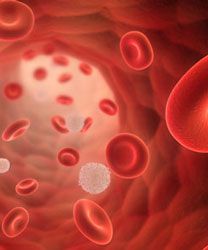MRD Associated With Worse Outcomes in AML
According to results published in <em>The New England Journal of Medicine</em>, molecular minimal residual disease was associated with a higher rate of relapse and a lower rate of relapse-free survival and overall survival for patients with newly-diagnosed acute myeloid leukemia.

According to results published inThe New England Journal of Medicine, molecular minimal residual disease (MRD) was associated with a higher rate of relapse and a lower rate of relapse-free survival (RFS) and overall survival (OS) for patients with newly-diagnosed acute myeloid leukemia (AML).
Samples from 2001 to 2013 of bone marrow or peripheral blood from 482 patients with previously untreated AML (n =428) or refractory anemia with excess of blasts were collected by investigators. To be considered in this study, patients had to be in fall into one of two categories in terms of remission: complete remission (CR) or CR remission with incomplete hematologic recovery with less than 5% blast cells in the bone marrow after receiving 2 cycles of induction chemotherapy.
Next-generation sequencing was used at diagnosis to find mutations that could serve as a marker for residual disease. The Illumina TruSight Myeloid Sequencing Panel (Illumina) was used for the next-generation sequencing to detect mutations in 54 genes commonly found in patients with hematologic cancers. Investigators found at least 1 such mutation in 430 patients (89.2%) from the study.
NPM1, DNMT3A, FLT3, and NRAS were the most detectable mutations. DTA mutations were the most common at rates of 78.7% for DNMT3A, 54.2% for TET2, and 51.6% for ASXL1. However, the majority of mutations in NRAS, PTPN11, KIT, and KRAS were cleared after induction therapy.
Detection of MRD was associated with a higher relapse rate (55.4% vs 31.9%; HR, 2.14; P <.001) compared to no detection, while there were lower rates of RFS (36.6% vs 58.1%; HR for relapse or death, 1.92; P <.001) and OS (41.9% vs 66.1%; HR for death, 2.06; P <.001).
“In this study, gene sequencing and multiparameter flow cytometry each had independent and additive prognostic value with respect to rates of relapse and survival in patients with AML,” corresponding author Peter J.M. Valk, PhD, Erasmus University Medical Center, department of hematology, Rotterdam, the Netherlands, and colleagues wrote.
“The detection of residual leukemia with both methods is associated with an excessively high probability of relapse (approximately 75%), and the absence of detection of residual disease with both methods is correlated with a relatively low probability of relapse (approximately 25%). Thus, the combined use of sequencing and flow cytometry during complete remission warrants further development and evaluation in clinical practice."
Patients who were positive for at least 1 mutation were randomly assigned to either a training cohort (n = 283) or a validation cohort (n = 147).
The detection of any persistent mutation, in the training cohort, during CR was associated with an increased risk for relapse. At 4 years, the relapse rate was 48.2% with detection compared with 32.4% with no detection (P = .03). Investigators discovered a correlation of persistent mutations with an increased relapse risk, appearing to be independent of allele frequency.
There was no significant assosication of detection of persistent DTA mutations with a higher 4-year relapse rate compared with no detection (P = .29). There was also no correlation with the independent of allele frequency.
In the patients who had persistent DTA mutations during CR, coexisting persistent non-DTA mutations had high prognostic value with 4-year relapse (66.7% with detection vs. 39.4% with no detection; P = .002).
“Thus, in patients with persistent DTA mutations, the presence of residual disease that specifically included coexisting non-DTAmutations represented a predictor of impending relapse,” Valk et al wrote.
Sequencing-based detection of non-DTAmutations in the multivariate analysis maintained significant independent prognostic value for relapse (HR, 1.89; 95% CI, 1.34-2.65; P <.001), RFS (HR, 1.64; 95% CI, 1.22-2.20; P = .001), and OS (HR, 1.64; 95% CI, 1.18-2.27; P = .003). There were also no significant interactions found between the detection of residual disease and the other prognostic factors in the multivariate model, type of consolidation therapy, or disease entity (AML vs. refractory anemia with excess of blasts).
Reference:
Jongen-Lavrencic M, Grob T, Hanekamp K, et al. Molecular minimal residual disease in acute myeloid leukemia [published online March 29, 2018]. N Engl J Med. 2018; 378:1189-1199. doi: 10.1056/NEJMoa1716863.